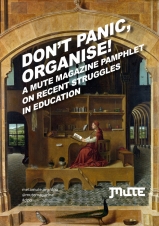Disappearer: Escaping the Online Spectacle
Rock ‘n’ roll was already slinking towards its third decade when a gang of Salford youths calling themselves The Fall released their second single, “It’s the New Thing”. They couldn’t have picked a more appropriate or perennial title: rock ‘n’ roll is nothing but the New, the Next, the Now,1 planned obsolescence in audio, chewing up and spitting out countless bands like cheap bubblegum. Satisfying this demand is the evergreen crop of up-and-comers awaiting anointment as the Next Big Thing. What has changed is the time scale: it used to be a few months for the machinery of major labels to crank into star-making mode. Now, bands barely out of the basement get boosted by blogs, earn breathless praise from tastemakers, and are summarily shat on by a cynical public within about a week – hype, juice, repeat.
This ouroborosian cycle seems to happen more and more often. Just a couple of years ago, rarely did a rookie band earn accolades and attention wildly disproportionate to their abilities. (Though it did happen. Here’s looking at you, Black Kids!) But over the past year, there’s been a near-monthly succession of acts, dripping amniotic fluid, jumping from obscurity to ubiquity faster than you can type “retweet”. Massachusetts power-poppers Dom, for example, were convened in January via a Craigslist ad; by March, they were buzzed about on websites; barely a month after that, online hegemon Pitchfork was gushing over the trio’s “innate understanding of the power of a killer hook.”2
As though there’s a shortage of bands adept at broad, patronizing musical gestures. I could similarly praise a toddler who can only declare the need to eat/sleep/shit as having mastered the raw essence of human communication – true, maybe, but it doesn’t make for great conversation. That’s exactly what happens, though, when an under-ripe act is thrust center-stage. A band uncomplicated by experience is going to have little personality and even less to say. Sure enough, the monikers of recent overhyped sensations – Wavves, Dum Dum Girls, The Drums – betray the thudding dullness of their music. The names seem tailored not to raise our expectations above reductive competence; god forbid the bands have to deliver on the intrigue invited by a name like Nurse With Wound, Wall of VooDoo, or even Nirvana.
But then, breaking new ground was never on the agenda. The Drums’ frontman Jonathan Pierce has claimed, “We've always tried to stay away from anything edgy or hip”3 – as though innovation wasn’t worth the risk of embarrassment. As though the future promises nothing but a perpetuation of the present’s numbing dread. Hence the retreat beneath the security blank of selective nostalgia, patching together yacht rock samples with sentimental Phil Spectoresque pop. The lo-fi smog currently wreathing indie rock is a suitable affectation for those whose hazy memories can't recall – or never knew – how awful much of the ‘80s were.
One new band on the block eschews retro-referentiality: Sleigh Bells. Their production is obnoxiously dry and in-your-face, without a reverb tail in earshot; and instead of tape hiss, they cloak their music in digital distortion. But let’s not mistake their music for what distinguishes them as distinctly contemporary: Sleigh Bells are basically Toni (“Hey Mickey!”) Basil as mastered by Merzbow. What marks Sleigh Bells as among a new breed of musician is their ingrained self-awareness. Witness the savvy self-cognizance displayed in this concert preview from Time Out NYC4:“When I was still in this stage when I wasn’t quite sure if I was going to stay in the classroom or apply for a different job, [guitarist Derek Miller] would kind of throw out all these things, like, ‘Wait till M.I.A. hears it! She’s going to love it!’” [frontwoman Alexis] Krauss says. “‘If [New Yorker staffer Sasha Frere-Jones] heard this, he would get it!’ I was just like, ‘Yeah, sure, Derek. You’re crazy. Nice try.’ But a lot of those people have said that exact thing: ‘We get it!’ What they get, I don’t quite understand, but we’re happy to have them along.”
Along with name-dropping Spike Jonze, Sleigh Bells disavow any studied posturing: “We both have tremendous respect for bands that are that calculated in the way that they design their image and their aesthetic. I just don’t think that’s our strength.” Of course, all-about-the-music self-effacement is as much a pose as anything Lady Gaga strikes, and a failsafe one within indie rock at that. Sleigh Bells further acknowledge their own anti-image-as-image by juxtaposing it against the “calculated” image of Garth Brooks.5 Beyond that, their certainty that celebrated trendsetters would “get it” suggests an almost instinctive understanding of culture industry infrastructure: syncretism, image construction, dissemination by those with the Midas touch. To Sleigh Bells, commodification isn’t the ugly caboose on the creative process – it’s the engine.
Sleigh Bells are far from the first freshman band to be pervasively self-aware. To one extent or another, every act that rockets to online omnipresence is similarly knowing and skilled at navigating the new media landscape. But if this new breed of band is born fully formed and sensitive of its identity, it’s because they’re each little more than a nexus of influences, a composite of pop-cultural winks and nods. Such is the Faustian bargain to avoid growing pains. Sure, they won’t stumble around stylistically as they find their artistic footing. But then either they become so beholden to their influences that they effectively have no personality of their own; or they become such a persona-driven pastiche of po-mo referentiality that there is precious little time or energy to spend on the actual music.
Of course there have been prodigious bands before, crackling with confidence and character from the first gig. But that’s lightning in a bottle, a once-in-a-decade phenomenon: The Shaggs, Teenage Jesus and The Jerks, Einstürzende Neubauten. A great many musicians that appear “out of nowhere” are in fact some Svengali’s test-tube baby (cf. the Sex Pistols). Further, once a band is in the spotlight, it’s easy to forget how much time they spent waiting in the wings. The vast majority don’t rush the stage: they bide their time, rigorously practice their craft, and only advertise their existence once they have something worth unveiling. It’s not that CBGB’s or the 930 Club was some divine altar that incarnated musical genius; it’s that these were open-minded venues that offered bad bands the chance to become better.
Most contemporary bands won’t have any such chance. Whether they publicize themselves or go viral through the digital grapevine, bands receive more attention earlier in their careers than ever before, and it’s almost impossible to escape the public eye once in it. Like an abusive relationship, it’s all giddiness and seductive adulation at first – but novelty fades, disappointment festers, then someone’s betrayed and left crying on the bathroom floor. We think by rushing to flatter fledgling bands, we’re doing them a favour, when in fact they’d benefit from the distance afforded by skeptical patience. Had The Boys Next Door existed concurrent with the blogosphere, the insouciant melodrama of their debut single, “Shivers”, would’ve won them gold stars from Stereogum and Pitchfork; they’d never have changed their name to The Birthday Party; and they’d likely have stayed off smack. But where would that leave us? Media burnout and dismissive rants on Hipster Runoff would have arrived before the band’s first full-length, and we’d never have gotten Junkyard.
A band is typically most derivative and referential immediately after its inception. Because so many amateur musicians draw from the same well, to elevate one upstart act above the undifferentiated rabble, attention must be quickly diverted from the music. The focus shifts to narrative, dress sense, an impressive LP collection or hip network of friends – everything superfluous to the music itself. The more assimilated into the culture industry a band becomes, the less its music matters. If it’s to remain genuinely “all about the music,” a band cannot exist as a public entity. Because of the viral mode of contemporary telecommunication, a band’s image – a representation of the band – can be reproduced well beyond a scope that the band can control. The band necessarily becomes about being the band, not about the music. The music can only be itself without the band to distract from it.
As a memetic echo chamber, the internet can repeat and amplify a band’s image until it drowns out its music. Consequently, no online presence is ideal – especially not the coy modesty and anti-image stooging so many current artists engage in. No, a band mustn’t make a spectacle of itself. If the number of interviews you’ve given exceeds the number of songs in your catalogue, you’re fucking up. Even the sonic currency of the internet, the MP3, is corruptive: it is but a consumer merit badge, congratulating its users on both their technocratic efficiency and cultural sensitivity. (“Check out this awesome Trojan Records playlist I downloaded!”) Thus, as a medium, it draws too much attention to itself and away from that which it carries: music. Because of – not despite – their awkward bulk and physical frailty, analog formats are preferable. Commodities they may be, but the format emphasizes concerted listening over convenience, and so the commodity is a more musical object.
So if every band on the internet is doing it wrong, who’s doing it right? Certainly not many, and fewer still that you or I have heard of. Though Steve Albini is an analog reactionary par excellence, as an artist he predates the digital paradigm. A more useful model would be a contemporary band formed amidst, yet contrary to, the online climate – a band like Sacramento scuzz-rockers Mayyors. They’ve no official web presence or promotional materials; their vinyl-only releases are limited beyond availability; and the only media evidence of their existence is bootlegged footage and slap-happy write-ups of their live appearances. No press shots; no banner ads; no viral videos; no interviews; no snarky blog digressions about stupid haircuts; and no elaborate and unlikely band member backstory involving South American cults, substance abuse, or foster homes.6 The chattering is restricted to among those who’ve attended the gigs and/or bought the records, and consequently there is nothing on which Mayyors’ reputation stands besides their music.
Until, of course, enough pop pundits talk up Mayyors’ punk reductivism such that the band becomes the symbolic figurehead of some new anti-digital authenticity. But goddamn it, that’s still a step in the right direction.
Seb Roberts is a musician, sound engineer, and writer in Tokyo, Japan. He also, of course, has a blog: And You May Find Yourself...
Footnotes
1 Of course, with one eye on efficiency, rock has always been more about recycling than revolution, as elder statesmen The Who cannily observed back in 1971 (“Meet the new boss/Same as the old boss”). So perhaps rock is neither about “The New” or “The Now”, but “The New-To-Now” or merely “The Novel”.2 http://pitchfork.com/reviews/albums/14176-sun-bron...3 http://pitchfork.com/news/36702-rising-the-drums/4 http://newyork.timeout.com/articles/music/85106/sl...5 Ibid.6 See: Devendra Banhart, Girls, Dom
Mute Books Orders
For Mute Books distribution contact Anagram Books
contact@anagrambooks.com
For online purchases visit anagrambooks.com






